[Review] Revival of “Oklahoma!”: A Wonderfully Weird Life-Changing Musical (4/5 Stars)
DURHAM, NC – A chilly night on March 29th for a beautiful production of Oklahoma! at the Durham Performing Arts Center (DPAC), a Tony award winner for best musical revival.
Arrival And Doors Opening
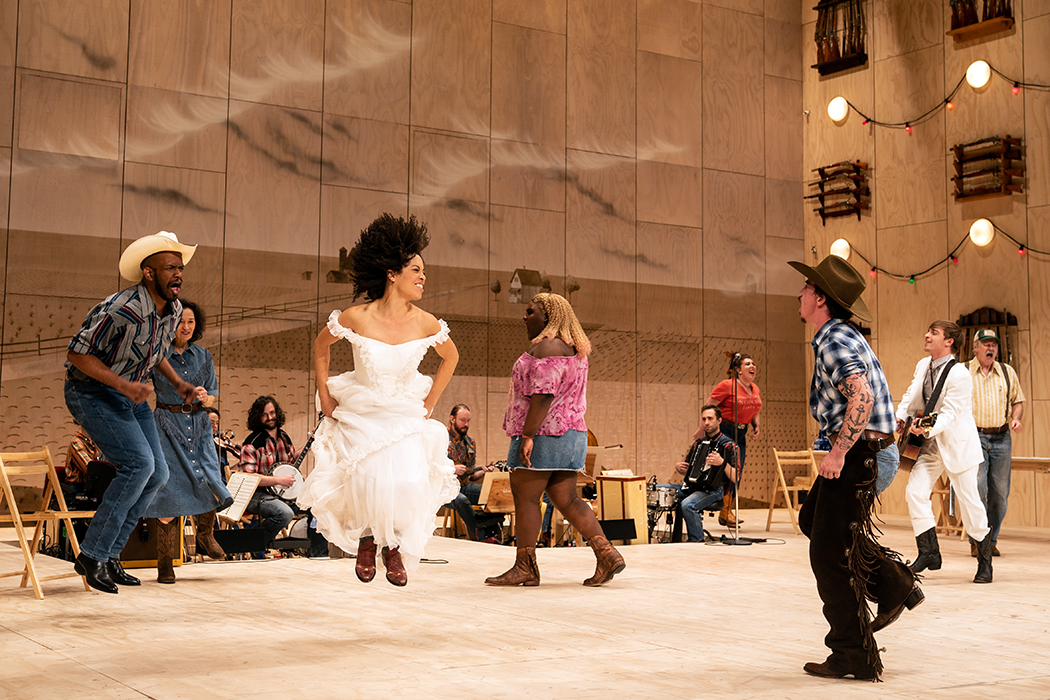
The lines were long as everyone scurried to get inside the grand entrance of DPAC. Waiting outside the several floors to get into the auditorium, chit chatter and quiet exchanges took place; everyone was excited to see the new take on Oklahoma!. Many were dressed in suits and dresses, while some chose a casual look. More notable to mention is that the former mayor of Durham, Stephen Schewel, arrived, who, just like everyone else, was anticipating the modernized production of Oklahoma!.
The doors opened at 7 pm, and a vast diversity of individuals made their way inside to claim their sacred seats. The luscious and oval-shaped grand auditorium tinted with maroon seats illuminated the plain center stage; a backdrop of a little farm and the bareness of the wooden tables made the production more original. As the musical began, the lights shone upon the smiling faces of audience members, quietly humming the words along to “Oh, What a Beautiful Mornin’.”
A Beautiful Dissatisfaction
After intermission, however, the smiling faces turned into solemn frowns. Many people had left or walked out, repelled by Daniel Fish’s dark and disturbing reinterpretation. Audience members were dissatisfied and confused with the new take on the musical, and whispers of critics nestled their way throughout the auditorium. One woman I sat beside, Cheryl (who was a delight to converse with), expressed her opinion. “This production is challenging. At the time period, this was written, the vernacular was very different. If they are going to modernize the musical, they need to modernize the vernacular as well. What really bugs me is their referral to coolers as baskets.” Although she held many criticisms, she did have a few optimistic pointers for the production. “I like that they incorporate diversity. It’s a nice look on stage to see women and men of different colors. I also like how they emphasize the power of women; women are not subjected to men in this production, which I appreciate.”
Another man I had the privilege to talk to, whose name is unknown, had a more gruesome criticism of the musical. “The darkness was too much; the gunshot terrified me. I was expecting an optimistic musical, but I received pessimism. I know it is to highlight American society right now, but I came to watch something great!”
Younger Viewers Loved It
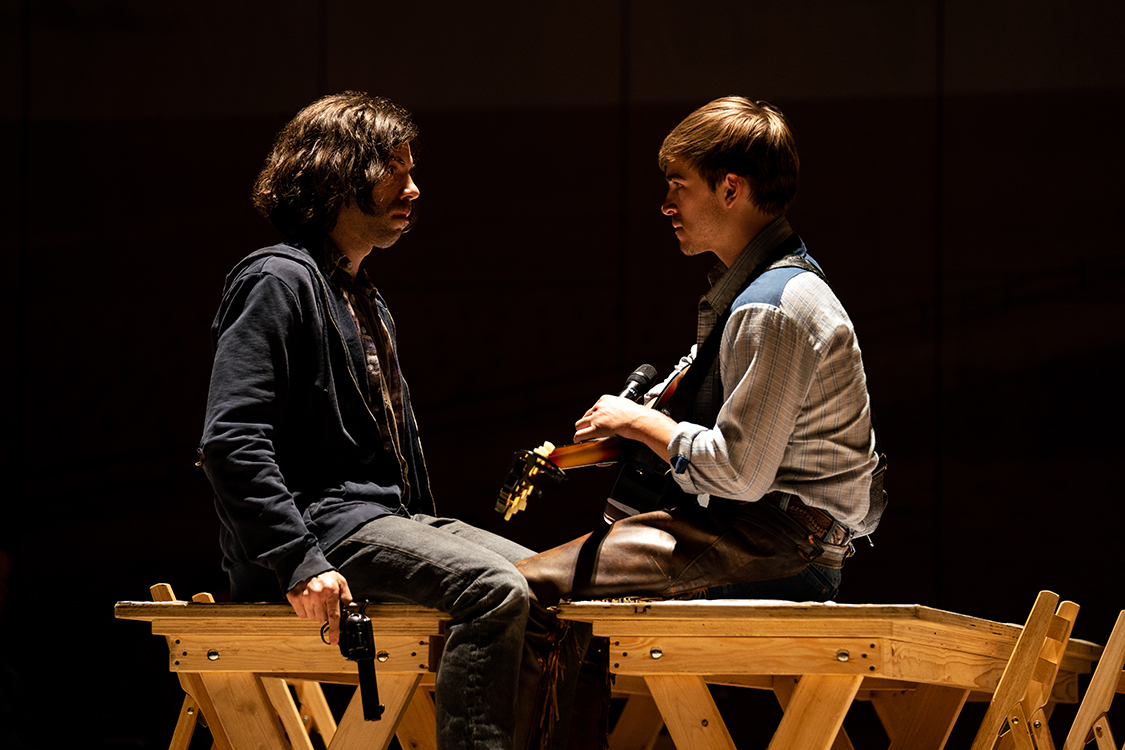
However, other younger viewers and I had a different experience. We loved the script, the lighting, the abstract dancing, and the horror, which seemed to discourage older audience members from enjoying the music. More importantly, we appreciate the allusion to the mental instability that Jud was suffering from. In this new production of Oklahoma! Fisher creates a disturbing scene that many older audience members didn’t necessarily understand. It was a conversation between Curly, played by Sean Grandillo, and Christopher Bannow as Jud, in the dark. Curly talks to Jud about what his death would be like if Jud hung himself; people who had disliked Jud would all come crying over his grave, begging for forgiveness, and individuals would unite together to mourn his death. Curly states, “We never know if people really love us till we die.” A short abstract clip reflects Jud’s facial expressions in the dark; he seems happy, rejuvenated with the thought of people finally caring about him, and appears to be considering the possibility of suicide. Some audience members didn’t understand the message, and some even laughed in ignorance at Jud’s response to a perceived death. Fish was demonstrating mental illness that overtakes our youthful society; in my college alone in the previous year, at the University of North Carolina at Chapel Hill, two people committed suicide on campus. Understanding the signs and symptoms of someone like Jud, who seems to be suffering from a mental illness, can make a difference in someone’s life.
A young Duke woman, around the age of twenty, had the same opinion as me. She states, “creativity and darkness is something we need to see and be aware of. The world isn’t sunshine of daisies and rainbows. This is real life, and mental illness is there.”
What Is Oklahoma!?
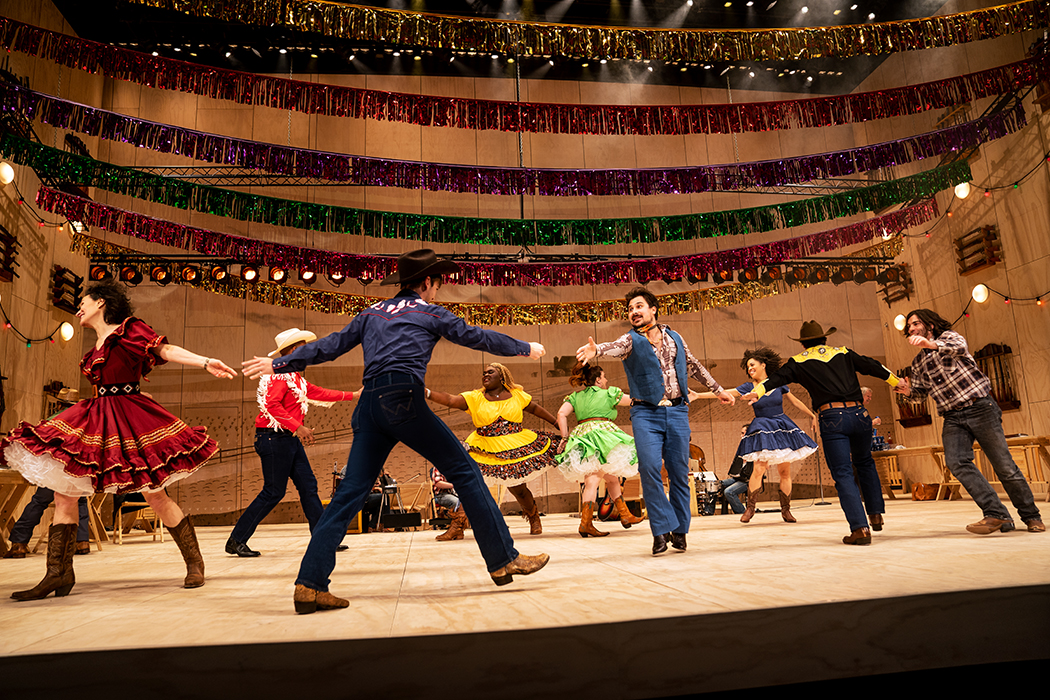
The new “Oklahoma!” production is not something your grandparents witnessed; it is a rejuvenated version of the classic 1943 Rodgers and Hammerstein musical that keeps the original script. It does a grand job of incorporating gender and racial equality while also drawing awareness to mental health. A unique version of Oklahoma! brings to the stage 21st century influences; actors of different races, sexual orientations, and religions reflect the diversity of American lives. They are costumed in modern clothing— t-shirt, blue bell-bottoms, cowboy hats, and boots.
The Plot
Oklahoma! which Rodgers and Hammerstein adapted from Lynn Riggs’s 1931 play, “Green Grow the Lilacs,” has a simple plot: the plot revolves around a cowboy, a farmhand, and a young farm girl. A cowboy named Curly, a handsome and humorous young man wants to take a farm girl, Laurey, to a box social. However, a love triangle persists throughout the musical as Jud Fry, a creepy and mysterious man who happens to be Laurey’s worker, seeks to make her his wife. With his guitar and beautiful melodic hum, a swooning Curly grasps the audience members’ hearts to root for him and Laurey. Jud Fry is dead by the end of the musical, and Laurey is married to Curly. Seems like a romantic, heroic battle where the loving and good moral man wins the beautiful woman, right? Wrong.
The Dark Side of Oklahoma!
Fish’s revival production of Oklahoma! turns Curly ( into a murderer; this loving, sweet, and innocent character audience members fell in love with breaks their hearts. In the original production of Oklahoma!, Jud arrives at the wedding and dies from a knife in a brawl caused by his own fumbling.
However, in Fish’s revival production of Oklahoma!, Jud arrives with a present to the groom at the wedding; he is nervous off-putting, and the audience seems to cling to their seats in anticipation of what he is about to do. He was the bad guy, after all. Curly receives a gun from Jud, who then walks across the stage, practically begging for death. His present, to Curly, was his death. Expecting the humble and kind Curly to put down the gun, blood splatters across the white clothes of the bride and groom; in a swift motion, without hesitation, Jud was shot dead. Although he was a little dark and overbearing, was Jud really the good guy all along? Fish’s revival emphasizes 21st-century dating to portray a message to the audience: we don’t know what others will do. Although they may seem beautiful on the outside, their hearts can be plagued with darkness on the inside.
Early 1900 Oklahoma!
When the production Oklahoma! first premiered on Broadway in 1943, the world was vastly different from the one we live in today. First and foremost, the Civil Rights Movement had not yet occurred; African Americans were still struggling in an endless fight for freedom. Moreover, women in the early 1900s were subjected to a status of inferiority and servitude to men; they were expected to perform household duties and raise children. Unlike men who held jobs in the political sphere of the world, women were confined to domesticity and obedience. However, the world has evolved towards a more equal sphere for races and gender, and the modernized production of Oklahoma! reflected these improvements.
Evolution of the World: Oklahoma! Matches it
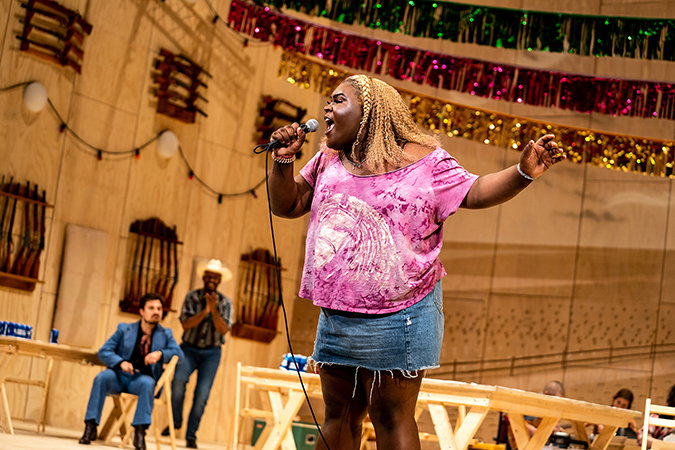
Ado Annie, performed by Sis, was the embodiment of female power. Unlike the early 1900s, in which women were subjected to inferior status, the 21st century has empowered women to be independent self entities entitled to the same rights as men. The production, “Oklahoma!” portrays just that with the boisterous and floozy women character Ado Annie. A character, who would normally be criticized and shamed in the early 1900s for her sleeping around with multiple men, was respected and liked. In the song “Many a New Day,” Aunt Eller, Laurey, Ado Annie, and Gertie sing about women’s empowerment; they endorse the proposition that it is okay to be without a man and that they don’t need to rely on one to be happy. Rather than the man subjecting and toying with the women like they did decades prior to the 21st century, “Oklahoma!” portrays women in a powerful light; it is Ado Annie that is chasing and messing around with different men, unlike men who sought out wives in the past. She holds power in deciding who she wants to marry, unlike women in the early 1900s who were told by their parents whom they should marry.
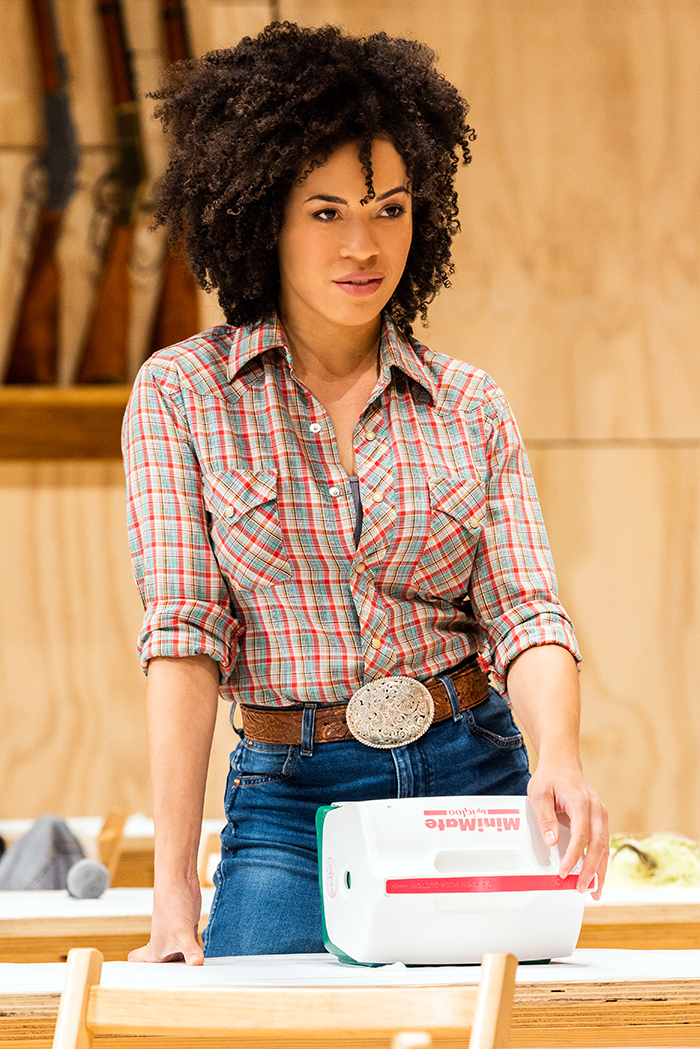
Laurey Williams, played by Sasha Hutchings, is the most important character for emphasizing racial equality. As you may have guessed, at the time this musical was produced, cast members in Oklahoma! were white. Sasha Hutchings, performing as Laurey, an African American woman, is the lead role in the romantic feud between Curly and Jud. After years of fighting for the same opportunities as white actors, many are now seeing the changes on and off-Broadway stages. Although these words may not be written for a Black woman, Sasha embodies them and makes the role seem as if it was meant for her.
I would rate Oklahoma! a 4 out of 5 stars. Even though the production cast new light on gender, sex, and mental illness, I could not ignore the critics of others. Oklahoma! is an uncomfortable but wonderfully weird life-changing musical you won’t want to miss.
Age Requirement
“Please note that all guests require a ticket, regardless of age. Children under the age of 6 are not allowed at this performance. Children must be able to sit quietly in their own seats without disturbing other guests. As a further courtesy to our guests, DPAC recommends one parent or chaperone for every one child in attendance.” ~ DPAC
Tickets
Tickets start at the price of $26.50 per person and increase by the designated spot of the audience member’s choosing.
Future Show-Times Include:
Thursday, March 31st at 7:30 pm
Friday, April 1st at 8:00 pm
Saturday, April 2nd at 2:00 pm and 8 pm
Sunday, April 3rd at 1:00 pm and 7:00 pm


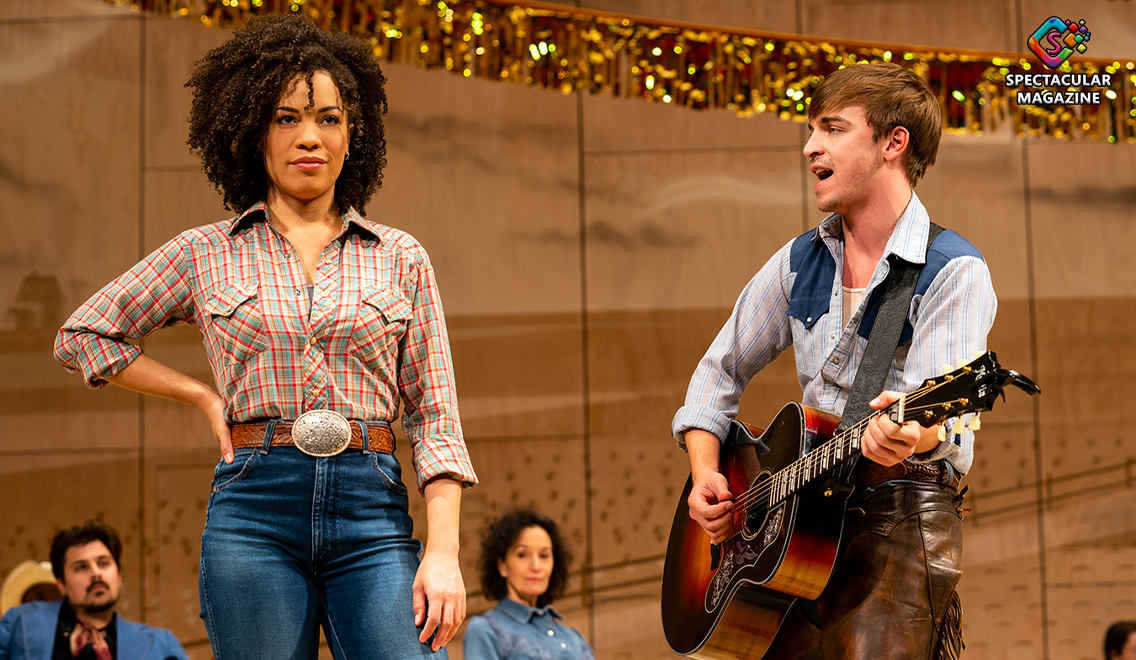
Review of Oklahoma
You definitely have a different perspective. I’m not sure we saw the same musical.
I would have expected a revival to take into account the differences in male-female relationships between the 1950’s and today. As you mention, this version did a grand job of incorporating gender and racial equality. And some of the presentation portrayed some of those differences.
I was concerned when the opening number was so slow — more like a “beautiful mourning” than a “beautiful morning”. The stage, which I read afterwards was originally for a theater-in-the-round, looked like it was designed on a limited budget. A picnic hamper was replaced by a plastic igloo.
The “dance” at the beginning of the second act was the most painful ten minutes of sight and sound that I have experienced at DPAC. The “music” made me cover my ears. One person I talked to afterwards had been a modern dancer and she said that it was the worst she had seen.
The actors gave a flat performance. I can speculate that their morale is way down since it appears about a fifth of the house leaves after the first act. They must feel like they are trapped in the show and will do anything to make it a little more fun. Jud’s comic death (walking a bit after being shot and then lying down) was part of that fun.
The performance took place on April 2nd. If it had been a day earlier, that might have explained the joke.
The performance did provoke discussion. We met a young black woman who had escaped during the “dance” of the 2nd act and was sitting outside waiting for her friends. Her reaction was like ours. We went for a drink afterwards and saw a couple with programs in their hands. It only took a quick “so what?” to establish our common reaction.
I won’t give it a star rating, since I think it’s unrateable.
Having not done any research before the show, I was definitely looking forward to the songs of Oklahoma, I remembered from a high school production. An insert play bill might have clarified what this production was trying to portray…mental health, woman inequality, racial issues, etc…not just a love triangle between a woman, a cowboy and a farm hand and some great music. The lack of scenery changes would have been more acceptable is the use of video technology had been better executed. The black outs and loud music were distracting…and didn’t seem to add value.
Was it the skill set of the performers that didn’t bring the production to the standards we have had and come to expect in other DPAC shows? There were some strong voices when just singing but combining with the spoken lines not so powerful. Did the several outburst of a very loud laugh add value? The performer in the long dream ballet did not have the dance skills expected. I’m sure the performers find distracting and discouraging when people walk out as I have read happened in other reviews and even in this performance. We stayed to the end, but the comments we heard when exiting were mostly negative… from a mixture of racial and age attenders.
Suggestions: -Add a bi-line to the title Oklahoma, a dark revival
-Add an insert play bill to clarify this is a very different take on the Oklahoma of the 40’s-50’s era and keep an open mind.
I’m still processing what I saw yesterday! I will say that the performers were fantastic – that’s absolutely one positive!
The character of Jud has always been mentally ill. I didn’t understand the change of Curly really trying to talk him into suicide.
Ado Annie has always been about female empowerment, to a degree, despite the fact that her father still gets to decide who she marries.
“Laurey’s Ballet” is supposed to be about her struggle to choose between Jud and Curly. Whatever was happening on that stage was NOT that.
And making Jud’s death a cold-blooded murder, with Laurey and Curly covered in blood? Is that a statement about Curly tormenting Jud? Is it meant to symbolize the blood on white settlers’ hands as they expand westward?
My problem with the production is that the director’s message wasn’t at all clear. If it was just meant to be provocative for the sake of being provocative, then it succeeded. If it was meant to be provocative in order to give us something to think about, it succeeded. But if it was meant to convey something, well, I missed the message.
Richard Rodgers and Oscar Hammerstein are spinning in the grave This production(I use that word loosely ) was so bad a junior high school would have been 10 times better The audience started walking out after 30 minutes of this torture and at intermission 50% did not come back
This is the worst performance of Oklahoma I have ever seen. It was changed so much, that I did not recognize it. It should have had another name, because it was not the same musical I’ve enjoyed so much. The stage design was poor and it never changed. Sound system was deficient. Dancers needed more training to do a better job. Singers were good, but at times, when using the microphone they were too loud. All the musicians played well. The darker scenes and gunshots were disconcerting. A very disappointing performance.
I’d like to follow up on my previous comments.
I read a review that suggested the director was the one to have the lines spoken without emotion. So the cast was doing their best within that constraint. They did have fun with the parts such as goodbye kissing, arithmetic, laughing and the death scene.
Spoiler alert – Jud dies. In the original, which I just watched, Jud hits Curley and pulls a knife. They get into a fight, and Jud gets stabbed with his own knife.
In this version, Jud gives Curley a gun and then no dialog is exchanged. He backs off ten feet and presents himself to be shot. Curly doesn’t shoot. Jud walks up to Curley and cocks the gun. He backs off again. Curley doesn’t shoot. He starts to walk up again and Curley shoots him. Jud ambles toward the front of the stage, then lies down. A great sight gag.
Another review suggested that almost every word in the original script was followed. Maybe except for “knife”. What this did was cause strange exchanges. At the beginning, Jud is sitting there and Curley says hello. Jud replies and then just sits there. In the original, Jud is walking across the stage and the exchange appears in context.
This was an issue with much of the production. A script is written in the context of the scene. A show written for a scene-less production needs words to set the context. Otherwise the viewer gets lost, as happened several times.
The actors performed admirably considering all these issues.
The performing arts centers who hosted this show really took a risk. Would the number of people leaving after the first act without buying a drink be offset by those buying doubles so they could stand the 2nd act? I speculate the “dance” scene was moved to the 2nd act to reduce the number of people leaving after the 1st.
This was not “Rodgers & Hammerstein’s Oklahoma” as the playbill reads. This was “Oklahoma” in words only.
As previous reviewers stated, you need truth in advertising.
This production was like a college theater arts class project to modernize a classic Broadway musical, and it would have been appropriate as such. The problem is this, though: the time of the musical is still early 1900’s, and events mentioned are from THAT time (e.g., dealing with Alexander Graham Bell’s phone). Race relations in the early 1900’s, especially between a white male and black female, were not what we saw. So, there was a verisimilitude problem. The lines needed to be changed to reflect modern times. The performers were talented, but somehow there was a lack of chemistry between the male and female leads that made a love relationship seem unlikely. Instead of a semi-operatic beefy baritone and lithe soprano we got a latter-day John Denver-with-guitar mixed with a young I’m-Every-Woman Whitney Houston. The beautiful, melodic songs that we treasured and wanted to hear as written and orchestrated were treated in a way that cheapened them—it was like if someone sang the Star Spangled Banner with a kazoo or Nessum Dorma with a banjo. The “ballet” looked like someone having a seizure during a deafening guitar lead, and this prompted many of the audience to leave at this time. In summary, I would not try to modernize a classic musical like this because it turned into a mess.